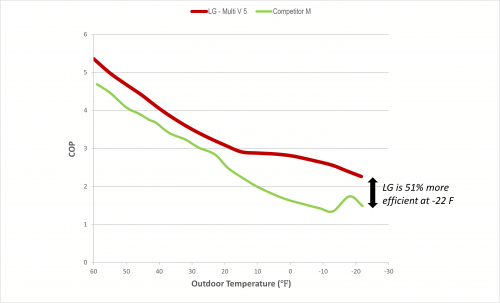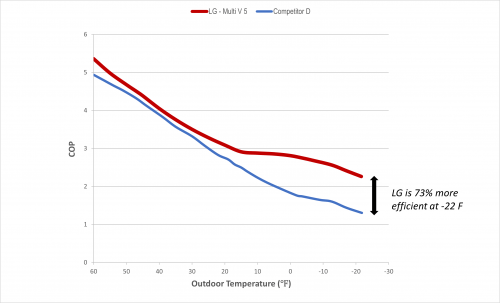Variable refrigerant flow (VRF) technology has an important role in the quest for Net Zero in Ontario. With multiple manufacturers touting heat output to -23F (-30C) ambient temperatures, VRF is a simple solution for building electrification. It also comes with the added benefit of delivering exceptional energy performance.
O’Dell collected performance data from the three major VRF manufacturers in Ontario. The results highlight how LG is uniquely positioned to support your building’s net zero design. As a point of comparison, we considered the 12-TON outdoor unit (ODU). The results are similar across all ODU capacities. LG has the additional benefit of offering up to 20-TONS in a single chassis, reducing the number of electrical connections and associated installation costs. The competitors have dual chassis at capacities above 12-TONS.
Heating Capacity
All three manufacturers have rated capacities to -23F (-30C). Output at -23F varies amongst the manufacturers as they all employ proprietary compressor and refrigerant technologies. (See Figure 1) Looking at heat output is a key factor in meeting your building loads, but in isolation doesn’t offer any real differentiator between manufacturers. Let’s look at power input for the same 12-TON ODU.

Figure 1: Heat Output
Power Input
As the saying goes, “there’s no free lunch”! At ~0F, both competitor’s power input spikes to maintain their low ambient heating output. (See Figure 2) The graph below shows that power input is a clear differentiator for LG. Remember, every AMP counts!

Figure 2: Power Input
COP
Tying heat output and power input together, we get COP. The graphs below show LG is 51% and 73% more efficient than Competitor M & D, respectively.

Figure 3: COP LG vs. Comp. M

Figure 4: COP LG vs. Comp. D
Real World Implications
Now that we’ve geeked out on data, what does this mean in a real world application? We have taken a recent multi-unit residential project and completed an electrical profile vs. Competitor D. This was a 575/3 project, so Competitor M doesn’t have a solution.
As a result of the superior efficiency of LG VRF, the total electrical load is 295-AMPS (36%) less than D. That’s a LOT of power! If you consider that solar panels have an average output of 12.6W/ft2, you’d need an additional 24,416-ft2 of solar to accommodate competitor D power requirements. That’s a significant burden in the quest for net zero.

Every amp counts when designing a net zero building. There is a trickle down effect on all other decisions for the overall building design. The implications can be enormous for the economics of the building and strategies undertaken to meet net zero goals. Give O’Dell a call on your next building and we’ll help deliver value in your designs.






